Australian Shepherds vs Border Collies
January 5, 2021 2021-08-15 20:07Table of Contents

Introduction
To someone unfamiliar with the two breeds of dogs they might look nearly identical, distinguished only by Aussies having a docked tail and Border Collies having a long natural tail.
However, the breeds come with different origin, temperament, talents, training challenges and characteristics.
If you are on the verge of deciding for either one, read on to find out which one exactly is your perfect match. Let’s get started with our ultimate comparison of the Australian Shepherd vs Border Collie.
History: Australian Shepherds vs Border Collies
The breed origin can tell us a lot about a dog’s temperament. While both Australian Shepherds and Border Collies are herding dogs, they were developed for quite different styles of work.
The saying “It’s all in how you raise them” is not true. As everyone who has owned a working dog knows, genetics are powerful and will determine your dog’s behavior and disposition. It is crucial to know what your dog was bred for and how this will influence his temperament.
It is very important to realize that both breeds were developed for endurance and strong work ethic. They do not make good couch potato dogs. Centuries of selecting for hard-working, tireless dogs created the breeds we know nowadays. If you are not ready to live with a working dog, neither breed is the right choice.
Let’s dive into the origin of Border Collies and Aussies:
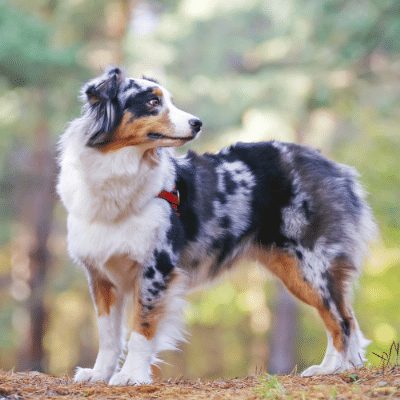
Australian Shepherd History
The Australian Shepherd is not – as the name might suggest – from Australia.
Instead, he originated in the Western United States. Back in the 1500s when Spaniards first got settled on the new continent, they needed herding dogs to help them tend their sheep. Some dogs they originally used were wolf-like and a lot larger than today’s Australian Shepherd, though they already showed their characteristic black and tan colors.
The settlers also utilized another dog breed, the Carea Leonés. This was a smaller dog that often had a merle pattern and blue eyes (closely resembling today’s Aussie).
Dog breeding back then of course happened outside of any registries or breed standards. The dogs were bred to fit the task on hand: herding large flock of sheep in New Mexico, California and Colorado. Australian Shepherd’s ancestors especially excelled in herding flocks through the difficult terrain of the Rocky Mountains.
Where exactly the “Australian” in their name comes from is not completely clear. Some suspect that it is derived from the Merino Sheep that were bred in large numbers in Australia and imported to the US.
Others believe that it derives from their looks: the characteristic blue merle patterning was found in many dogs imported from Australia and became the name for any dogs of that appearance.
Border Collie History
The Border Collie was developed on the other end of the world in the meantime.
When Romans first invaded the British Isles in the first century, they brought sheep and herding dogs with them. These dogs were larger than today’s Border Collies and quickly spread across Britain.
When the Viking invaded, they brought a smaller, agile dog (similar to today’s Spitz) with them. For many centuries these two types of dogs were crossed with each other, once again without striving towards a certain physical breed standard. Farmers bred dogs that had good working qualities, and selected for these traits in their puppies and further generations as well.
In 1893, the forefather of today’s Border Collie was born, a dog named “Old Hemp”. Old Hemp is said to have sired as many as 200 pups. He had an outstanding working ability and personality that was passed onto his many descendants.
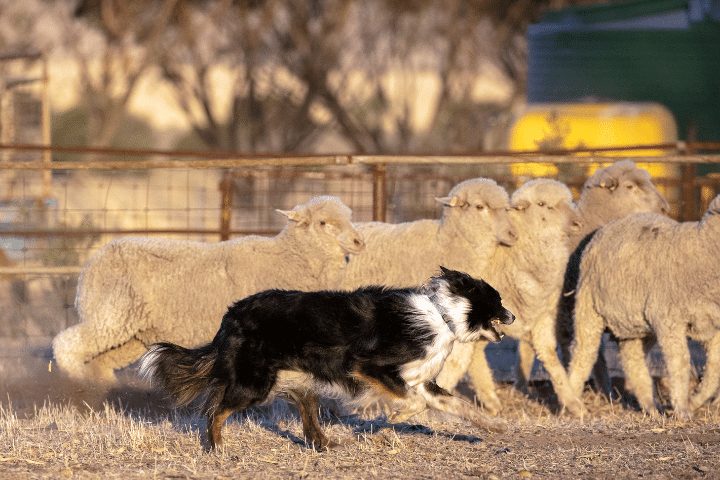
Appearance: Australian Shepherd vs Border Collie
While they are similar in appearance and might even look identical to the untrained eye, there are actually many little differences between the breeds. Once you know what to watch out for, they will not look the same anymore!
In a nutshell, Aussies are stockier, have a wider and softer face and always have floppy ears, compared to the often prick ears of Border Collies.
Let’s look at their differences in detail:

Australian Shepherd Appearance
Australia Shepherds are 18-21 inches (females) and 20-23 inches (males) tall. Their weight ranges from 40-55 lbs for females and 50-65 lbs for males.
They have a solid built and are slightly longer than tall. They lush coat is medium-length and straight or slightly wavy. Especially males can have an impressive mane on their neck.
Australian Shepherd’s tail can be natural, docked or a natural bobtail. Their ears are supposed to be a “button ear”, meaning that they break forward and sit to the site a little bit.
Some Australian Shepherds have prick or erect ears, though this is considered a fault by the AKC.
Border Collie Appearance
Border Collies are slightly lighter than Aussies. They are 18-21 inches (females) and 19-22 inches (males), weighing between 30 and 55 lbs.
While Aussies always have a rough coat, Border Collies come in two varieties: rough coat and smooth coat. Rough coated dogs can range from light feathering to a lush, thick and long coat (especially in show line dogs). The rough coat is a recessive gene, meaning that both parents have to carry a copy of the gene in order to produce rough coated offspring.
Border Collies can have prick, tipped or dropped ears. Some owners tape their Border Collies’ ears to get them to stand up.
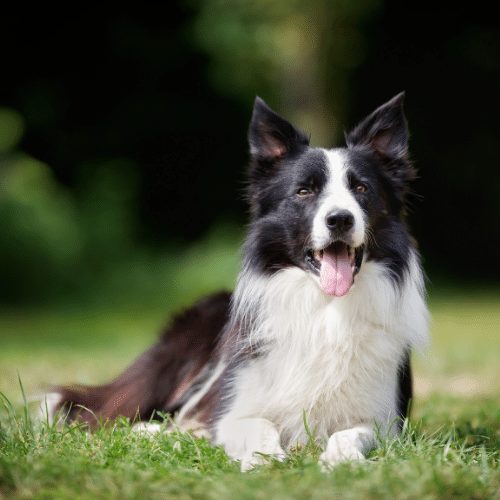
Colors & Patterns
Aussies are known for their frequent merle patterns while Border Collies are traditionally often black and white. The classic white marking around the neck, on the legs and in form of a blaze in the face are called “Irish Markings”. Border Collies’ tails always have a white tip.
While merle (especially blue merle with tan points) is associated with Australian Shepherds, it can occur in Border Collies as well.
Merle Border Collies are often confused with Aussies for that reason. If you want to tell the breeds apart, look at their features in addition to their coloring. (By the way: All Aussie colors are allowed colors in the Miniature Australian Shepherd breed.)
In addition to the main colors mentioned below, Border Collies also come in brindle and the dilute colors of lilac and blue.
Black & White
Black and white, both with and without tan, is seen in both Aussies and Border Collies.
In general, tan (the “extra” brown markings on the cheeks, eyebrows and along the legs) are much more common in Australian Shepherds than in Border Collies, though there are Border Collies with tan and Australian Shepherds without.
Black and white most commonly occurs with Irish Markings, though dogs can also have irregular white markings. The blaze can be thin, run diagonally across the face or be broken up. “Split faces” where one side of the face is white and the other one black are also seen and especially stunning.
This waving cutie is an Australian Shepherd!

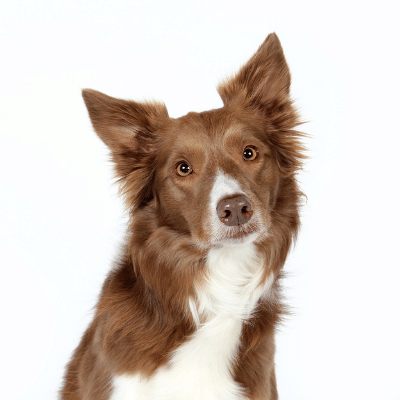
Red & White
Red and white is also found in both breeds. The red coloring is recessive, that means both parents need to carry a copy of the gene to produce it in the offspring.
If a black dog of either breed that does not carry the gene is crossed with a red one, all offspring will be black. If two red dogs are crossed, all offspring will be red.
This inquisitive dog is a Border Collie. Compare his features with the ones of the Aussie above – they are quite different if you look closely!
Merle
Merle is not a color but a pattern. It can be combined with any base color. In merle hairs are randomly lighter than others, giving the dog a spotted appearance.
A black dog with a merle pattern is called a blue merle. A red dog with a merle pattern is simply a red merle.
Merle is much more associated with Aussies than with Border Collies, though it appears in both breeds.
The dog in front of the green background is a Border Collie and the one in front of the yellow one is an Aussie.
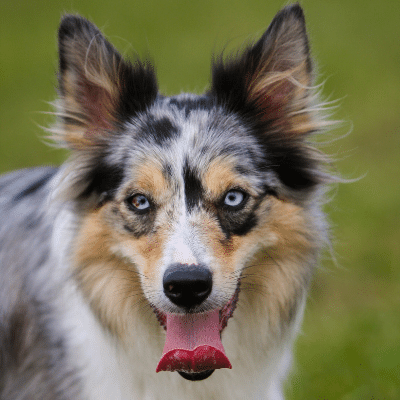

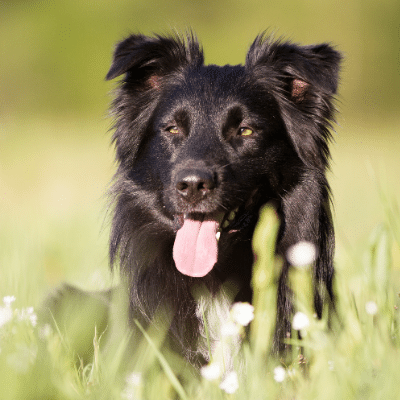
Solid Color
Both breeds can appear with minimal or no white markings as well. This is more common in Australian Shepherds than in Border Collies.
Because we are so used to seeing the classical white markings of blaze and collar on the breeds, dogs without them can appear to be a mixed breed – but they are as much a purebred as dogs with white! Solid colored dogs can have small spots of white, for example on their chest.
Merle can also appear with or without white markings.
Eye Color
Aussies are known for sometimes having or or two blue eyes, especially in the merle pattern. However, it does occur in black and white dogs without the merle pattern as well.
Border Collies can show blue eyes as well, and both breeds’ eyes can have shades ranging from gold over green to a dark brown.
If a dog has a merle pattern, this can extend to the eye and result in a patterned/bi-colored eye. The eye color does not affect the dog’s vision.
Pictured is an Australian Shepherd with two brown and blue eyes.
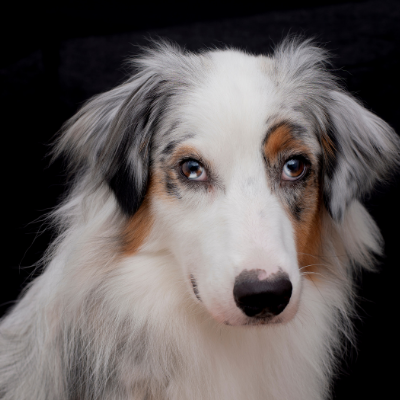
Working Or Show Line?
While the first dogs of both breeds were developed for their working ability only, nowadays there are different breed registries that breed dogs to fulfill a certain physical standard. The American Kennel Club (AKC) is the biggest breed registry in North America and features both the Border Collie and Australian Shepherd as a registered breed.
Dogs that were bred to abide the AKC standards and take part in conformation shows are called “show line”. Show line dogs in general tend to have a thicker coat, heavier built and less innate herding ability – as the breeding stock is not selected with mostly working ability in mind.
Show line dogs are a great introduction to the herding breeds. They tend to be less intense and easier to handle for beginner dog owners.
(Note: Many sports dogs – such as for agility – also come from the AKC registry. These dogs are mostly not low-drive and easy-going and absolutely need a job. A true show line dog is one who was bred to excel in conformation shows.)
Border Collies have a registry for working dogs, the ABCA (American Border Collie Association).
Working Border Collie breeders strive to set themselves apart from show line breeders. The types of dogs they are breeding can look very different and appear like two individual breeds.
Breeders of working line Border Collies breed for working ability and do not select pairings based on looks. ABCA has a much higher percentage of smooth coated Border Collies compared to the AKC. Below is a comparison of a show line and a working line dog:
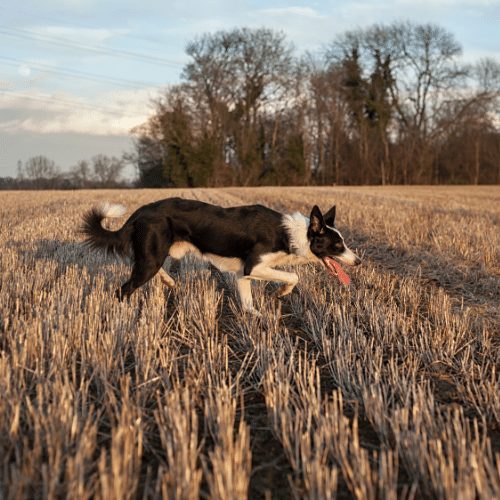
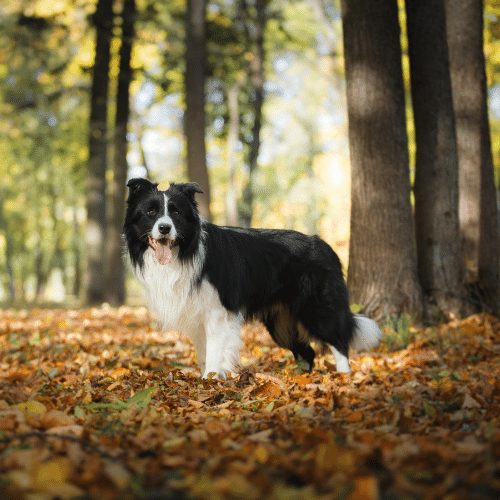
In certain parts of the US, it is popular to cross both breeds with the Australian Cattle Dog to crate the Texas Heeler, a hard-working farm dog.
Behavior: Australian Shepherds vs Border Collies
Their appearance might be similar, but in their behavior Border Collies and Australian Shepherds can differ quite a bit! Carefully consider which breed’s temperament is best suited to your needs when you are deciding for one breed or the other.
As herding dogs, both love to learn, can show motion sensitivity and are likely to be a bit nervy at times. They won’t be laid-back couch potatoes. With the right training however, they can absolutely learn to relax when it is time to. In fact, when raising either breed you want to take care to teach them to have a co-called “off-switch”.
Aussies Love Food
Every owner of an Aussie will tell you how much his dog loves food! This can make training both easy and hard – on the one hand an Aussie is likely to try his hardest for the smallest piece of kibble, on the other he might lose his mind trying to earn it. Aussies like to throw all behaviors they have learned at you at once when there is the possibility of getting a treat.
Aussies can steal and ingest surprising amounts of food if unsupervised. You might need to out up baby gates to your kitchen forever or be very diligent about putting away food. One of my own friends’ Aussies once ate a 1 lbs jar of garlic supplements, resulting in a multi-day stay at the doggy ICU.
Teaching self control skills around food will be crucial, and a big part of your training. The great thing about this high food drive is that it allows you to train around a lot of distractions, and without your Aussie getting tired of training any time soon – as long as a treat can be earned, he will be game!
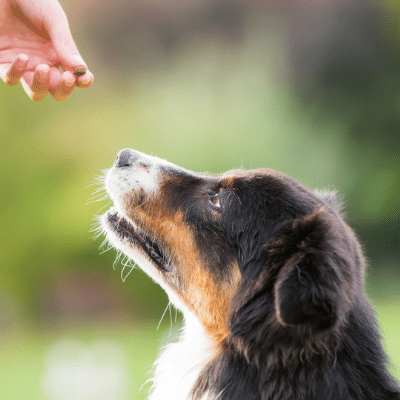
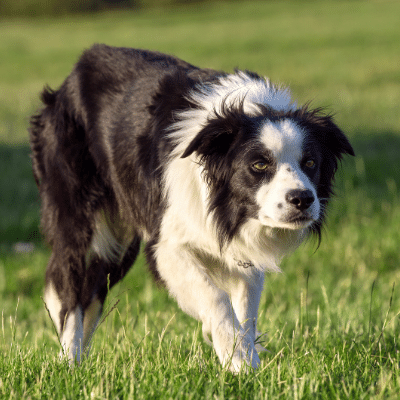
Border Collies Stalk
Border Collies herd by using the “eye”, meaning making intense, unbroken eye contact and at times moving seemingly in “slow motion”. They have a tendency to react this way to many forms of motion, not just livestock.
If your dog is anticipating that you will throw a ball or frisbee or he watches other dogs run around, he might go into the typical Border Collie stalk pose.
Border Collies should not be allowed to stalk kids or smaller pets of the household of course. Stalking and watching motion can become an excessive behavior, so keep an eye on your dog and intervene if necessary.
A bit of stalking will always be a part of living with a Border Collie, but it can get out of hand. Some dogs for example start to stare at reflections or dust particles in the sun for hours a day. If this is the case you should restrict your dog’s access to those areas and consider working with a local dog trainer to address it.
Aussies Bark
Aussies love to let you know what they think – and they are not shy about being loud!
Australian Shepherds bark when they are excited, when they are having fun, when they see something suspicious, when they want to alert you … and just for plain fun as well!
If you are a person who does not like a barking dog, an Australian Shepherd is not for you.
There is no way to get them to completely stop barking – it is ingrained in their genes and part of who they are. This makes them less than ideal apartment dogs as well – close neighbors might not appreciate their desire to be heard!
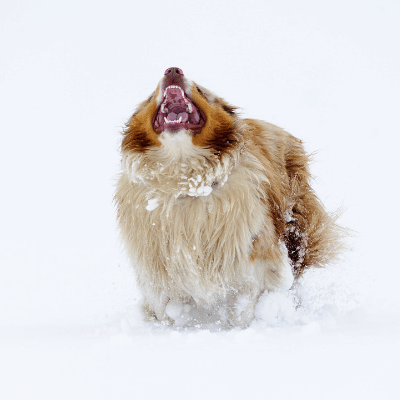
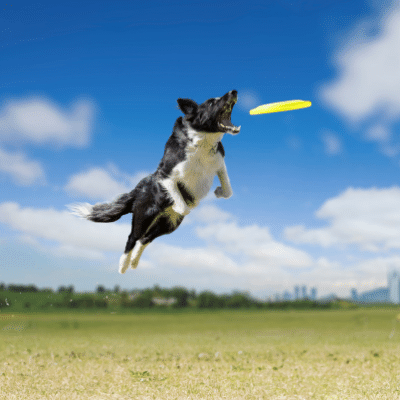
Border Collies Have No Quits
Both breeds have a high energy level and work ethic, but the Border Collie is especially tireless and will work himself (and you!) to the ground if not stopped.
On the one hand, this makes him a perfect companion for highly active people. If you are are looking for a dog to take on long backpacking trips or to teach a thousand tricks, there is no better fit than the Border Collie.
On the other hand, your Border Collie will require mental and physical exercise every day of his life – also when you don’t feel like it, when the weather is bad or when you had a long day at work. If this sounds overwhelming, it is probably not the right breed for you.
A bored Border Collie will not be pleasant to have around. They are likely to engage in destructive behaviors such as chewing, obsessive light chasing, licking their own paws until they’re bleeding, or chasing their own tail relentlessly.
Reactivity
Both breeds can show reactive behavior if they are not properly socialized. Being bred to work as herding dogs in vast pastures with their livestock, they are not made to be social butterflies like Golden Retrievers.
Some dogs will be more suspicious of strangers than others. This can be due to their genetics to some extend. However, if you do not expose your young Aussie or Border Collie to a variety of different people and situations in which they can make positive experiences, it is likely that they will show reactivity.
In fact, the most prevalent dog breed in our Tackling Reactivity Online Class is – the Aussie. This is in part due to the fact that they are not known to become reactive, so many puppy owners put socialization and exposure on the backburer.
Do not make that mistake! Both herding breeds will need to be taken out and about and introduced to the world. If you attempt to raise and Aussie or Border Collie on your property only, some kind of reactivity is nearly certain in the future.
Sports with Aussies & Border Collies
Both breeds excel in dog sports. Their will to please and keen desire to work together with their owner makes them perfect teammates for a variety of canine activities.
If you own an Aussie or Border Collie, you should definitely consider trying out one or more sports with him. Your dog will love the fun bonding time with you, and you will as well!

Having “a job” will give your dog an outlet for physical and mental energy. It is really important that your training includes some aspect of brain work and thinking.
Any Aussie or Border Collie will gladly chase a ball for hours each day. This is not healthy or beneficial though: By giving your dog purely physical activities, you will build a canine super athlete who craves bigger and bigger adrenaline rushes.
Dog sports are a perfect way to combine physical activity with thinking and mental challenges. You will find that your dog is more tired after 15 minutes of concentrated training than he is after an hour of thoughtless racing around in the yard.
Border Collies & Australian Shepherds With Kids
Many parents wonder whether an Aussie or a Border Collie would be the better addition to their family.
The only answer for this is: neither one.
It is important to realize that these dogs are not naturally outgoing, social butterflies who love to meet and greet people and have endless patience. They can be successfully integrated into a family with kids and become great pets, but it will require work and supervision. If parents are looking for an easy-going, laid-back dog, there are other options such as many toy breeds and their mixes. Cavachons, Chiweenies or Morkies can be more suitable for a family looking to add their first dog.
Herding dogs were bred to work tirelessly and do their job. They are as we mentioned motion-sensitive and can be high strung and a bit on the nervy side.
They are not a good dog if you are looking for a companion animal who can just hang out with your family. Do not get an Aussie or Border Collie puppy if you are not ready to invest time, energy and money into training, exercise and enrichment.
If you let your herding breed puppy do what he wants all day, he will quickly pick out hobbies that you will dislike – such as nipping at your kids’ heels, barking at the fence incessantly or chasing your cat.
In order to make a puppy successful as a family pet, you need to teach him manners through positive, patient training and set aside time every day to interact with him. This should include both mental and physical exercise – herding dogs need both!
Especially Australian Shepherds like to cuddle with their owners after some good, tiring exercise – they are hard workers AND lap dogs in one. If a committed owner is providing stimulating activities every day for their dog, these herders can even live in apartments.

Thank you to Jess Bell from Jess Bell Photography (Instagram here) for the beautiful picture in the heading.


